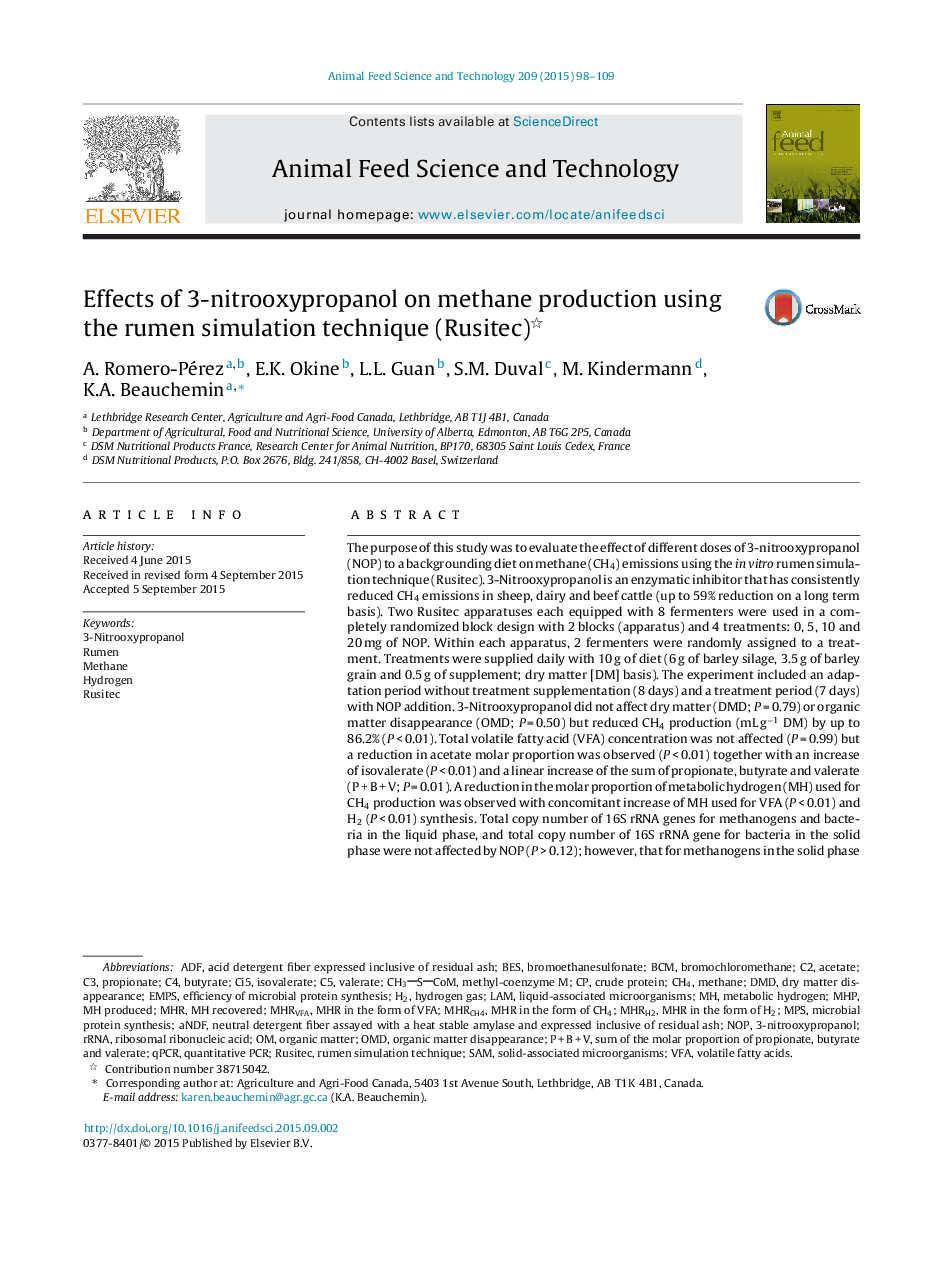| کد مقاله | کد نشریه | سال انتشار | مقاله انگلیسی | نسخه تمام متن |
|---|---|---|---|---|
| 2419375 | 1552376 | 2015 | 12 صفحه PDF | دانلود رایگان |

• Addition of 3-nitrooxypropanol (NOP) reduced methane emissions by up to 86.2%.
• Total volatile fatty acid (VFA) concentration was not affected by NOP.
• The molar proportion of acetate was reduced by up to 8.7% with NOP.
• Metabolic hydrogen was mainly re-directed to VFA when NOP was present.
• Methanogens were reduced by NOP in the solid phase but not in the liquid phase.
The purpose of this study was to evaluate the effect of different doses of 3-nitrooxypropanol (NOP) to a backgrounding diet on methane (CH4) emissions using the in vitro rumen simulation technique (Rusitec). 3-Nitrooxypropanol is an enzymatic inhibitor that has consistently reduced CH4 emissions in sheep, dairy and beef cattle (up to 59% reduction on a long term basis). Two Rusitec apparatuses each equipped with 8 fermenters were used in a completely randomized block design with 2 blocks (apparatus) and 4 treatments: 0, 5, 10 and 20 mg of NOP. Within each apparatus, 2 fermenters were randomly assigned to a treatment. Treatments were supplied daily with 10 g of diet (6 g of barley silage, 3.5 g of barley grain and 0.5 g of supplement; dry matter [DM] basis). The experiment included an adaptation period without treatment supplementation (8 days) and a treatment period (7 days) with NOP addition. 3-Nitrooxypropanol did not affect dry matter (DMD; P = 0.79) or organic matter disappearance (OMD; P = 0.50) but reduced CH4 production (mL g−1 DM) by up to 86.2% (P < 0.01). Total volatile fatty acid (VFA) concentration was not affected (P = 0.99) but a reduction in acetate molar proportion was observed (P < 0.01) together with an increase of isovalerate (P < 0.01) and a linear increase of the sum of propionate, butyrate and valerate (P + B + V; P = 0.01). A reduction in the molar proportion of metabolic hydrogen (MH) used for CH4 production was observed with concomitant increase of MH used for VFA (P < 0.01) and H2 (P < 0.01) synthesis. Total copy number of 16S rRNA genes for methanogens and bacteria in the liquid phase, and total copy number of 16S rRNA gene for bacteria in the solid phase were not affected by NOP (P > 0.12); however, that for methanogens in the solid phase was reduced (P < 0.01). Total protozoal cells were not affected (P = 0.61). Results showed that NOP addition to a backgrounding diet is an effective means of reducing CH4 production in vitro; however, less than 5 mg of NOP should be used in further studies when using Rusitec fermenters to better simulate in vivo conditions where much lower levels are used. The redirection of MH, mainly to VFA synthesis, when CH4 production was inhibited could be beneficial for animal production when supplementing NOP; however, the accumulation of H2 represents a loss of energy utilizable by cattle from feed.
Journal: Animal Feed Science and Technology - Volume 209, November 2015, Pages 98–109